PUBH6002: Global and Environmental Health - Air Quality in India
VerifiedAdded on 2023/01/19
|10
|2048
|87
Report
AI Summary
This report examines the critical issue of air quality in India, utilizing the DPSEEA framework to analyze the driving forces, pressures, state, exposure, effects, and actions related to air pollution. It highlights the significant impact of industrialization, poverty, and CO2 emissions on air quality, leading to severe health consequences and economic repercussions, including a decline in tourism. The report evaluates current government policies, such as the Air (Prevention and Control of Pollution) Act, and identifies gaps in their effectiveness. Recommendations are provided to enhance air quality, including increasing literacy rates, implementing stricter emission policies, promoting sustainable production practices, and encouraging the use of electric vehicles and public transportation. The report concludes that addressing air pollution requires a multifaceted approach involving governmental, corporate, and individual efforts to protect the environment and public health in India. Desklib offers this report as a valuable resource, alongside a wide range of solved assignments and past papers, to support students in their academic endeavors.
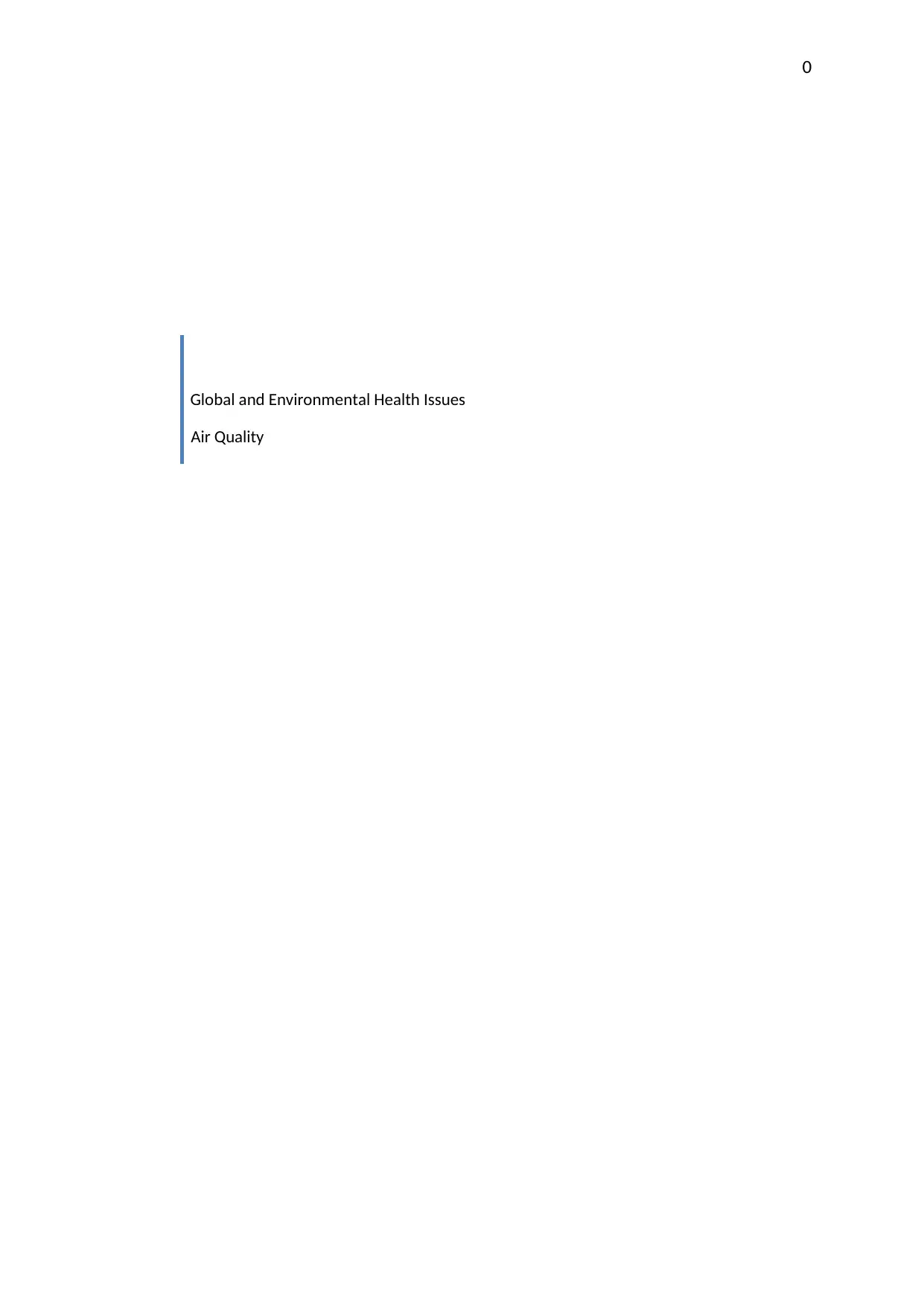
0
Global and Environmental Health Issues
Air Quality
Global and Environmental Health Issues
Air Quality
Paraphrase This Document
Need a fresh take? Get an instant paraphrase of this document with our AI Paraphraser
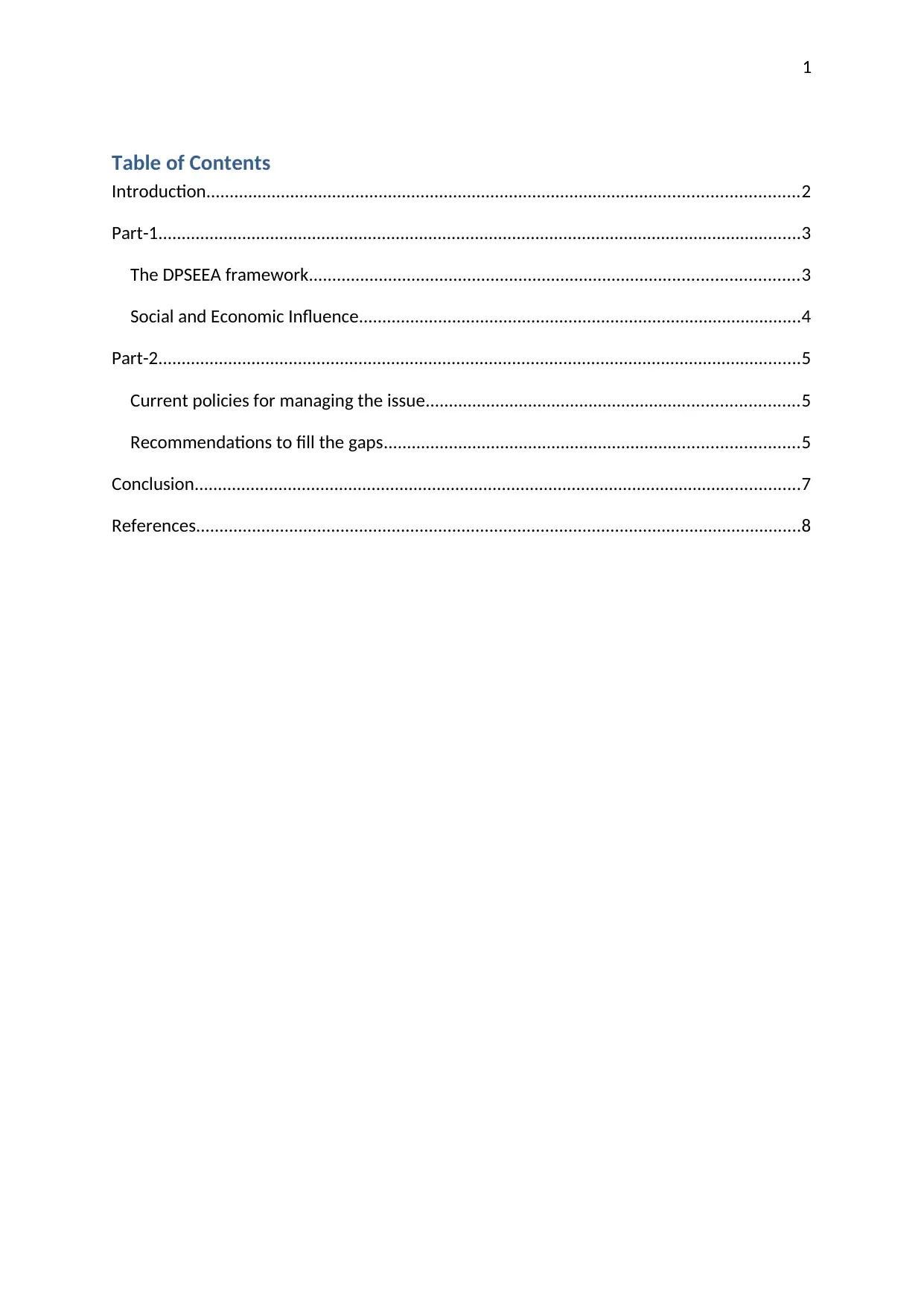
1
Table of Contents
Introduction...............................................................................................................................2
Part-1..........................................................................................................................................3
The DPSEEA framework.........................................................................................................3
Social and Economic Influence...............................................................................................4
Part-2..........................................................................................................................................5
Current policies for managing the issue................................................................................5
Recommendations to fill the gaps.........................................................................................5
Conclusion..................................................................................................................................7
References..................................................................................................................................8
Table of Contents
Introduction...............................................................................................................................2
Part-1..........................................................................................................................................3
The DPSEEA framework.........................................................................................................3
Social and Economic Influence...............................................................................................4
Part-2..........................................................................................................................................5
Current policies for managing the issue................................................................................5
Recommendations to fill the gaps.........................................................................................5
Conclusion..................................................................................................................................7
References..................................................................................................................................8
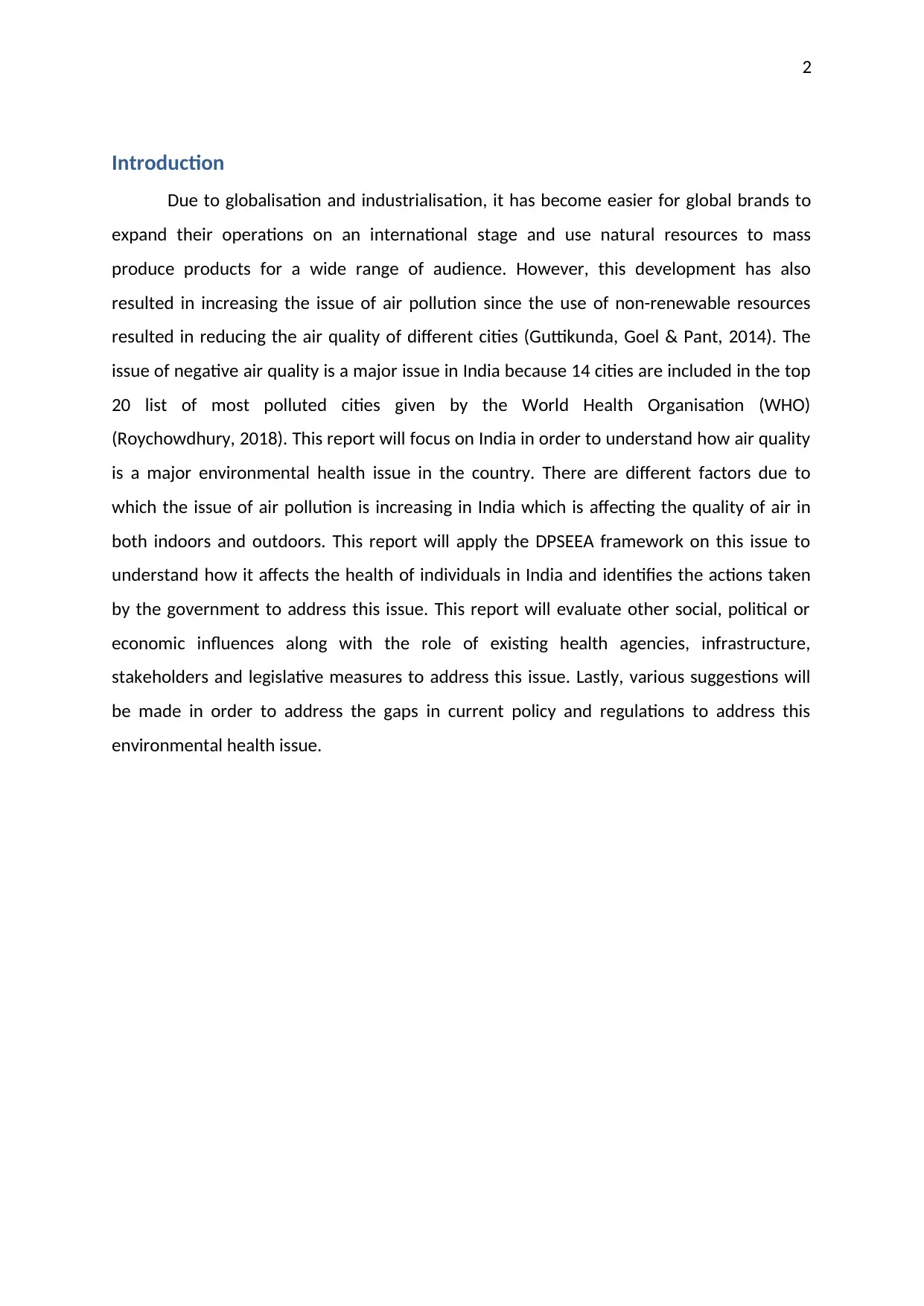
2
Introduction
Due to globalisation and industrialisation, it has become easier for global brands to
expand their operations on an international stage and use natural resources to mass
produce products for a wide range of audience. However, this development has also
resulted in increasing the issue of air pollution since the use of non-renewable resources
resulted in reducing the air quality of different cities (Guttikunda, Goel & Pant, 2014). The
issue of negative air quality is a major issue in India because 14 cities are included in the top
20 list of most polluted cities given by the World Health Organisation (WHO)
(Roychowdhury, 2018). This report will focus on India in order to understand how air quality
is a major environmental health issue in the country. There are different factors due to
which the issue of air pollution is increasing in India which is affecting the quality of air in
both indoors and outdoors. This report will apply the DPSEEA framework on this issue to
understand how it affects the health of individuals in India and identifies the actions taken
by the government to address this issue. This report will evaluate other social, political or
economic influences along with the role of existing health agencies, infrastructure,
stakeholders and legislative measures to address this issue. Lastly, various suggestions will
be made in order to address the gaps in current policy and regulations to address this
environmental health issue.
Introduction
Due to globalisation and industrialisation, it has become easier for global brands to
expand their operations on an international stage and use natural resources to mass
produce products for a wide range of audience. However, this development has also
resulted in increasing the issue of air pollution since the use of non-renewable resources
resulted in reducing the air quality of different cities (Guttikunda, Goel & Pant, 2014). The
issue of negative air quality is a major issue in India because 14 cities are included in the top
20 list of most polluted cities given by the World Health Organisation (WHO)
(Roychowdhury, 2018). This report will focus on India in order to understand how air quality
is a major environmental health issue in the country. There are different factors due to
which the issue of air pollution is increasing in India which is affecting the quality of air in
both indoors and outdoors. This report will apply the DPSEEA framework on this issue to
understand how it affects the health of individuals in India and identifies the actions taken
by the government to address this issue. This report will evaluate other social, political or
economic influences along with the role of existing health agencies, infrastructure,
stakeholders and legislative measures to address this issue. Lastly, various suggestions will
be made in order to address the gaps in current policy and regulations to address this
environmental health issue.
⊘ This is a preview!⊘
Do you want full access?
Subscribe today to unlock all pages.

Trusted by 1+ million students worldwide
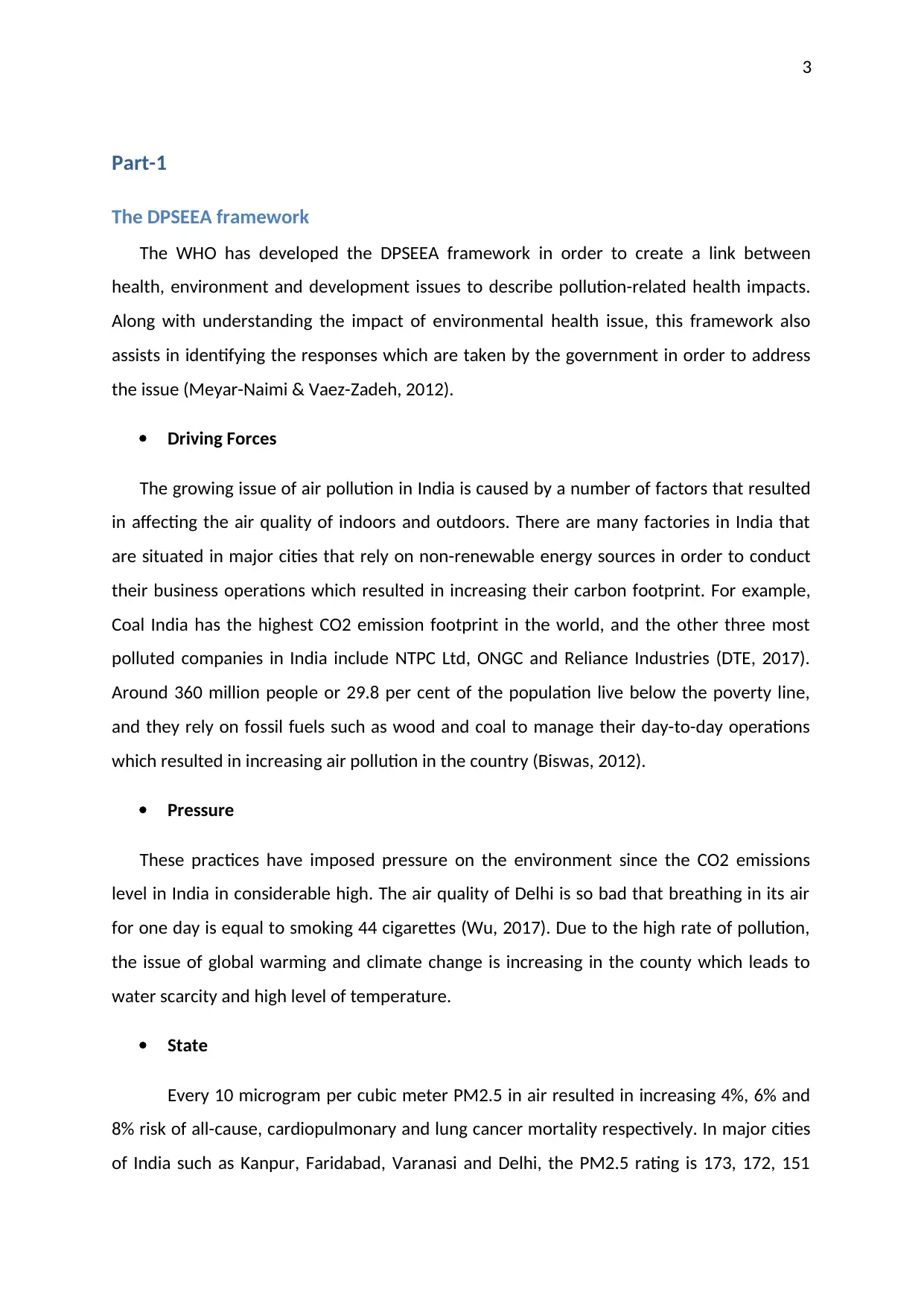
3
Part-1
The DPSEEA framework
The WHO has developed the DPSEEA framework in order to create a link between
health, environment and development issues to describe pollution-related health impacts.
Along with understanding the impact of environmental health issue, this framework also
assists in identifying the responses which are taken by the government in order to address
the issue (Meyar-Naimi & Vaez-Zadeh, 2012).
Driving Forces
The growing issue of air pollution in India is caused by a number of factors that resulted
in affecting the air quality of indoors and outdoors. There are many factories in India that
are situated in major cities that rely on non-renewable energy sources in order to conduct
their business operations which resulted in increasing their carbon footprint. For example,
Coal India has the highest CO2 emission footprint in the world, and the other three most
polluted companies in India include NTPC Ltd, ONGC and Reliance Industries (DTE, 2017).
Around 360 million people or 29.8 per cent of the population live below the poverty line,
and they rely on fossil fuels such as wood and coal to manage their day-to-day operations
which resulted in increasing air pollution in the country (Biswas, 2012).
Pressure
These practices have imposed pressure on the environment since the CO2 emissions
level in India in considerable high. The air quality of Delhi is so bad that breathing in its air
for one day is equal to smoking 44 cigarettes (Wu, 2017). Due to the high rate of pollution,
the issue of global warming and climate change is increasing in the county which leads to
water scarcity and high level of temperature.
State
Every 10 microgram per cubic meter PM2.5 in air resulted in increasing 4%, 6% and
8% risk of all-cause, cardiopulmonary and lung cancer mortality respectively. In major cities
of India such as Kanpur, Faridabad, Varanasi and Delhi, the PM2.5 rating is 173, 172, 151
Part-1
The DPSEEA framework
The WHO has developed the DPSEEA framework in order to create a link between
health, environment and development issues to describe pollution-related health impacts.
Along with understanding the impact of environmental health issue, this framework also
assists in identifying the responses which are taken by the government in order to address
the issue (Meyar-Naimi & Vaez-Zadeh, 2012).
Driving Forces
The growing issue of air pollution in India is caused by a number of factors that resulted
in affecting the air quality of indoors and outdoors. There are many factories in India that
are situated in major cities that rely on non-renewable energy sources in order to conduct
their business operations which resulted in increasing their carbon footprint. For example,
Coal India has the highest CO2 emission footprint in the world, and the other three most
polluted companies in India include NTPC Ltd, ONGC and Reliance Industries (DTE, 2017).
Around 360 million people or 29.8 per cent of the population live below the poverty line,
and they rely on fossil fuels such as wood and coal to manage their day-to-day operations
which resulted in increasing air pollution in the country (Biswas, 2012).
Pressure
These practices have imposed pressure on the environment since the CO2 emissions
level in India in considerable high. The air quality of Delhi is so bad that breathing in its air
for one day is equal to smoking 44 cigarettes (Wu, 2017). Due to the high rate of pollution,
the issue of global warming and climate change is increasing in the county which leads to
water scarcity and high level of temperature.
State
Every 10 microgram per cubic meter PM2.5 in air resulted in increasing 4%, 6% and
8% risk of all-cause, cardiopulmonary and lung cancer mortality respectively. In major cities
of India such as Kanpur, Faridabad, Varanasi and Delhi, the PM2.5 rating is 173, 172, 151
Paraphrase This Document
Need a fresh take? Get an instant paraphrase of this document with our AI Paraphraser
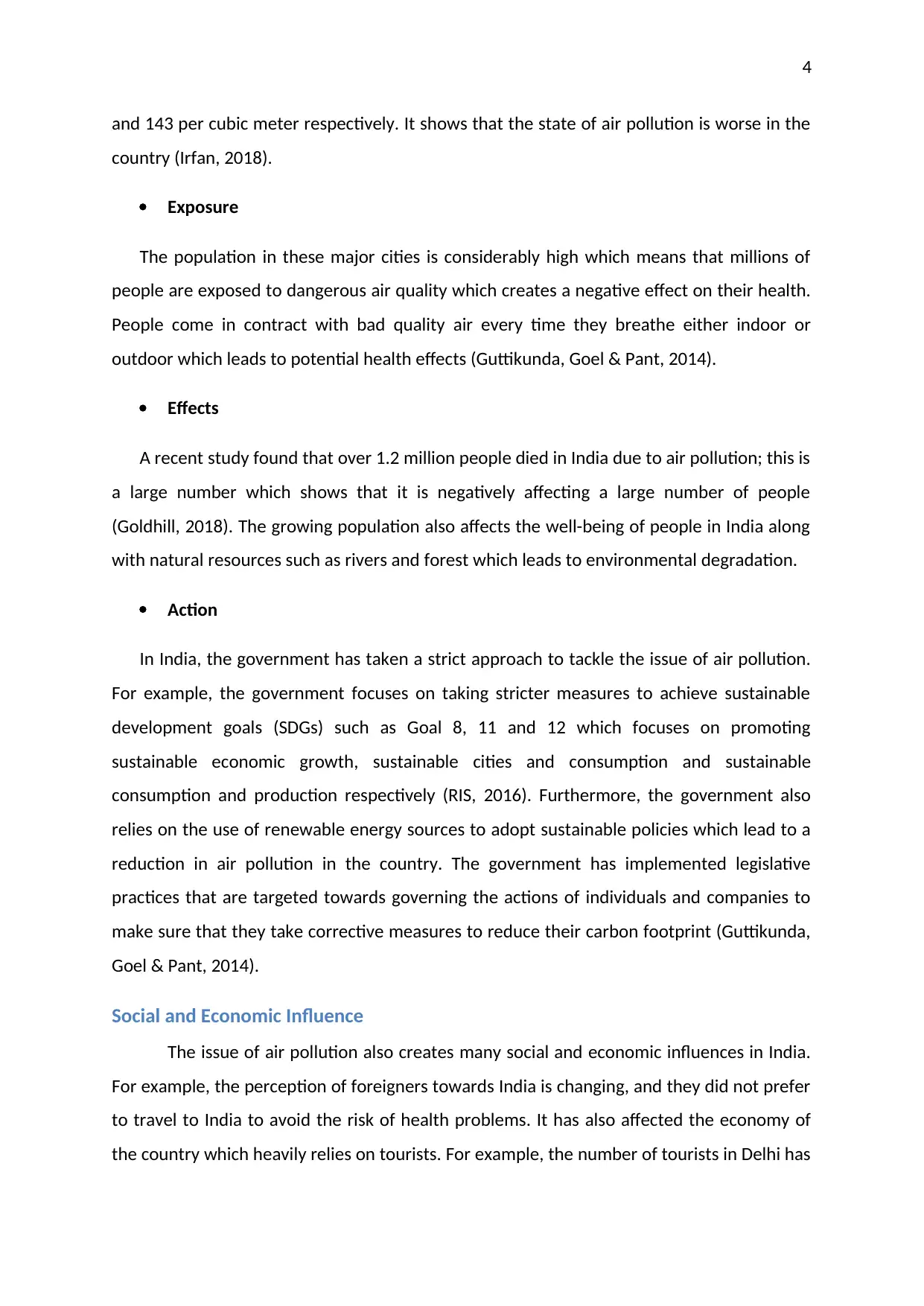
4
and 143 per cubic meter respectively. It shows that the state of air pollution is worse in the
country (Irfan, 2018).
Exposure
The population in these major cities is considerably high which means that millions of
people are exposed to dangerous air quality which creates a negative effect on their health.
People come in contract with bad quality air every time they breathe either indoor or
outdoor which leads to potential health effects (Guttikunda, Goel & Pant, 2014).
Effects
A recent study found that over 1.2 million people died in India due to air pollution; this is
a large number which shows that it is negatively affecting a large number of people
(Goldhill, 2018). The growing population also affects the well-being of people in India along
with natural resources such as rivers and forest which leads to environmental degradation.
Action
In India, the government has taken a strict approach to tackle the issue of air pollution.
For example, the government focuses on taking stricter measures to achieve sustainable
development goals (SDGs) such as Goal 8, 11 and 12 which focuses on promoting
sustainable economic growth, sustainable cities and consumption and sustainable
consumption and production respectively (RIS, 2016). Furthermore, the government also
relies on the use of renewable energy sources to adopt sustainable policies which lead to a
reduction in air pollution in the country. The government has implemented legislative
practices that are targeted towards governing the actions of individuals and companies to
make sure that they take corrective measures to reduce their carbon footprint (Guttikunda,
Goel & Pant, 2014).
Social and Economic Influence
The issue of air pollution also creates many social and economic influences in India.
For example, the perception of foreigners towards India is changing, and they did not prefer
to travel to India to avoid the risk of health problems. It has also affected the economy of
the country which heavily relies on tourists. For example, the number of tourists in Delhi has
and 143 per cubic meter respectively. It shows that the state of air pollution is worse in the
country (Irfan, 2018).
Exposure
The population in these major cities is considerably high which means that millions of
people are exposed to dangerous air quality which creates a negative effect on their health.
People come in contract with bad quality air every time they breathe either indoor or
outdoor which leads to potential health effects (Guttikunda, Goel & Pant, 2014).
Effects
A recent study found that over 1.2 million people died in India due to air pollution; this is
a large number which shows that it is negatively affecting a large number of people
(Goldhill, 2018). The growing population also affects the well-being of people in India along
with natural resources such as rivers and forest which leads to environmental degradation.
Action
In India, the government has taken a strict approach to tackle the issue of air pollution.
For example, the government focuses on taking stricter measures to achieve sustainable
development goals (SDGs) such as Goal 8, 11 and 12 which focuses on promoting
sustainable economic growth, sustainable cities and consumption and sustainable
consumption and production respectively (RIS, 2016). Furthermore, the government also
relies on the use of renewable energy sources to adopt sustainable policies which lead to a
reduction in air pollution in the country. The government has implemented legislative
practices that are targeted towards governing the actions of individuals and companies to
make sure that they take corrective measures to reduce their carbon footprint (Guttikunda,
Goel & Pant, 2014).
Social and Economic Influence
The issue of air pollution also creates many social and economic influences in India.
For example, the perception of foreigners towards India is changing, and they did not prefer
to travel to India to avoid the risk of health problems. It has also affected the economy of
the country which heavily relies on tourists. For example, the number of tourists in Delhi has
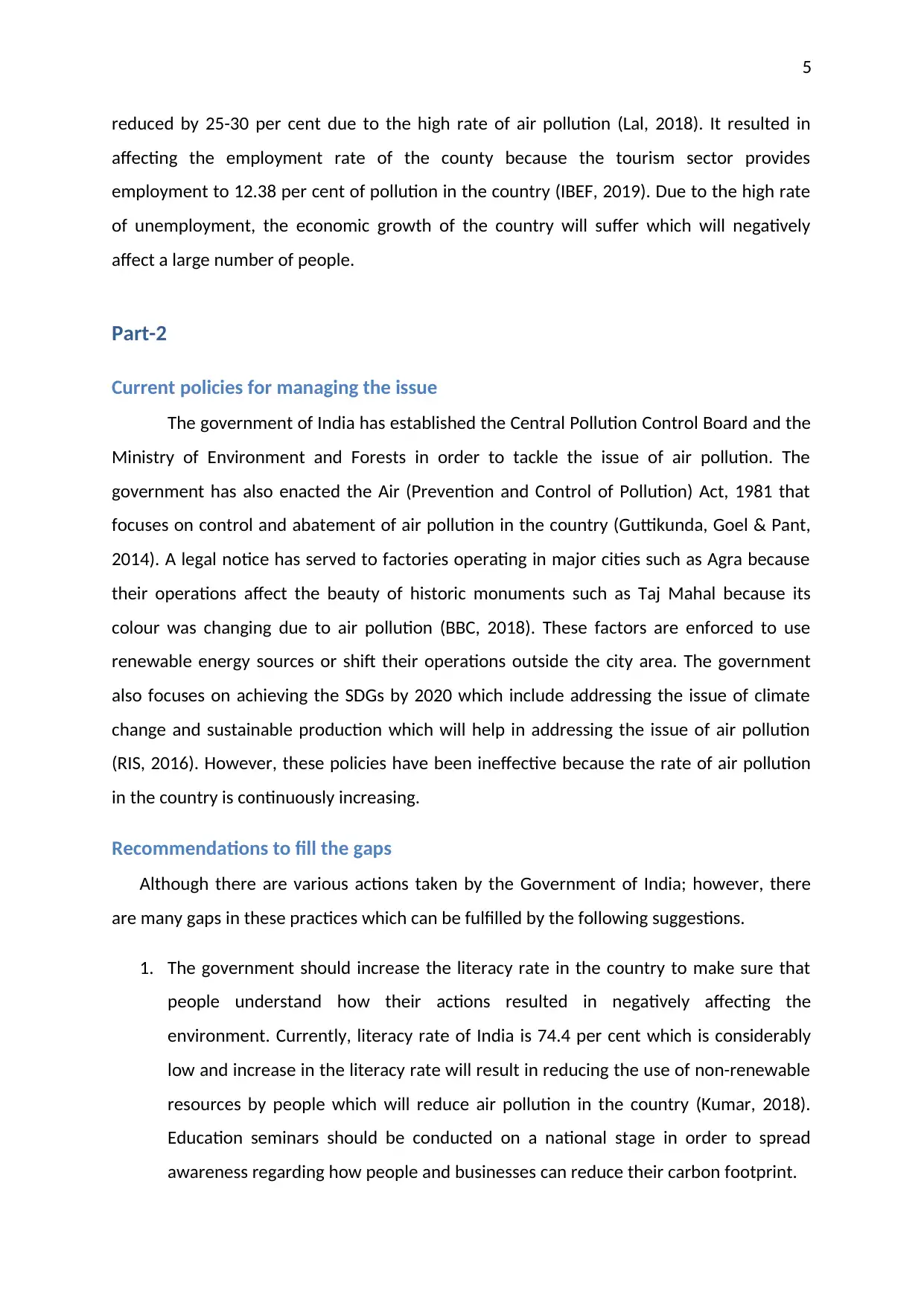
5
reduced by 25-30 per cent due to the high rate of air pollution (Lal, 2018). It resulted in
affecting the employment rate of the county because the tourism sector provides
employment to 12.38 per cent of pollution in the country (IBEF, 2019). Due to the high rate
of unemployment, the economic growth of the country will suffer which will negatively
affect a large number of people.
Part-2
Current policies for managing the issue
The government of India has established the Central Pollution Control Board and the
Ministry of Environment and Forests in order to tackle the issue of air pollution. The
government has also enacted the Air (Prevention and Control of Pollution) Act, 1981 that
focuses on control and abatement of air pollution in the country (Guttikunda, Goel & Pant,
2014). A legal notice has served to factories operating in major cities such as Agra because
their operations affect the beauty of historic monuments such as Taj Mahal because its
colour was changing due to air pollution (BBC, 2018). These factors are enforced to use
renewable energy sources or shift their operations outside the city area. The government
also focuses on achieving the SDGs by 2020 which include addressing the issue of climate
change and sustainable production which will help in addressing the issue of air pollution
(RIS, 2016). However, these policies have been ineffective because the rate of air pollution
in the country is continuously increasing.
Recommendations to fill the gaps
Although there are various actions taken by the Government of India; however, there
are many gaps in these practices which can be fulfilled by the following suggestions.
1. The government should increase the literacy rate in the country to make sure that
people understand how their actions resulted in negatively affecting the
environment. Currently, literacy rate of India is 74.4 per cent which is considerably
low and increase in the literacy rate will result in reducing the use of non-renewable
resources by people which will reduce air pollution in the country (Kumar, 2018).
Education seminars should be conducted on a national stage in order to spread
awareness regarding how people and businesses can reduce their carbon footprint.
reduced by 25-30 per cent due to the high rate of air pollution (Lal, 2018). It resulted in
affecting the employment rate of the county because the tourism sector provides
employment to 12.38 per cent of pollution in the country (IBEF, 2019). Due to the high rate
of unemployment, the economic growth of the country will suffer which will negatively
affect a large number of people.
Part-2
Current policies for managing the issue
The government of India has established the Central Pollution Control Board and the
Ministry of Environment and Forests in order to tackle the issue of air pollution. The
government has also enacted the Air (Prevention and Control of Pollution) Act, 1981 that
focuses on control and abatement of air pollution in the country (Guttikunda, Goel & Pant,
2014). A legal notice has served to factories operating in major cities such as Agra because
their operations affect the beauty of historic monuments such as Taj Mahal because its
colour was changing due to air pollution (BBC, 2018). These factors are enforced to use
renewable energy sources or shift their operations outside the city area. The government
also focuses on achieving the SDGs by 2020 which include addressing the issue of climate
change and sustainable production which will help in addressing the issue of air pollution
(RIS, 2016). However, these policies have been ineffective because the rate of air pollution
in the country is continuously increasing.
Recommendations to fill the gaps
Although there are various actions taken by the Government of India; however, there
are many gaps in these practices which can be fulfilled by the following suggestions.
1. The government should increase the literacy rate in the country to make sure that
people understand how their actions resulted in negatively affecting the
environment. Currently, literacy rate of India is 74.4 per cent which is considerably
low and increase in the literacy rate will result in reducing the use of non-renewable
resources by people which will reduce air pollution in the country (Kumar, 2018).
Education seminars should be conducted on a national stage in order to spread
awareness regarding how people and businesses can reduce their carbon footprint.
⊘ This is a preview!⊘
Do you want full access?
Subscribe today to unlock all pages.

Trusted by 1+ million students worldwide
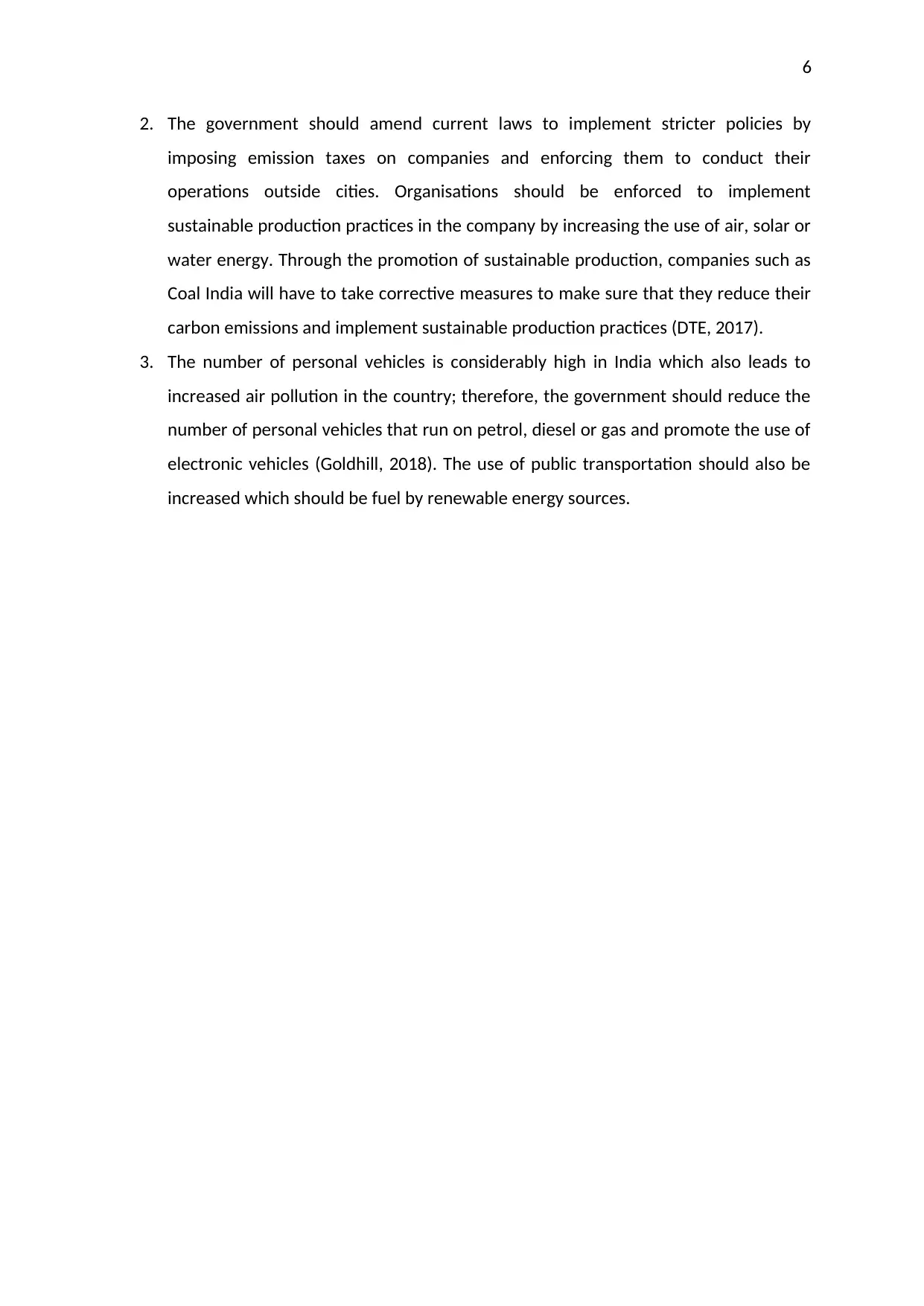
6
2. The government should amend current laws to implement stricter policies by
imposing emission taxes on companies and enforcing them to conduct their
operations outside cities. Organisations should be enforced to implement
sustainable production practices in the company by increasing the use of air, solar or
water energy. Through the promotion of sustainable production, companies such as
Coal India will have to take corrective measures to make sure that they reduce their
carbon emissions and implement sustainable production practices (DTE, 2017).
3. The number of personal vehicles is considerably high in India which also leads to
increased air pollution in the country; therefore, the government should reduce the
number of personal vehicles that run on petrol, diesel or gas and promote the use of
electronic vehicles (Goldhill, 2018). The use of public transportation should also be
increased which should be fuel by renewable energy sources.
2. The government should amend current laws to implement stricter policies by
imposing emission taxes on companies and enforcing them to conduct their
operations outside cities. Organisations should be enforced to implement
sustainable production practices in the company by increasing the use of air, solar or
water energy. Through the promotion of sustainable production, companies such as
Coal India will have to take corrective measures to make sure that they reduce their
carbon emissions and implement sustainable production practices (DTE, 2017).
3. The number of personal vehicles is considerably high in India which also leads to
increased air pollution in the country; therefore, the government should reduce the
number of personal vehicles that run on petrol, diesel or gas and promote the use of
electronic vehicles (Goldhill, 2018). The use of public transportation should also be
increased which should be fuel by renewable energy sources.
Paraphrase This Document
Need a fresh take? Get an instant paraphrase of this document with our AI Paraphraser
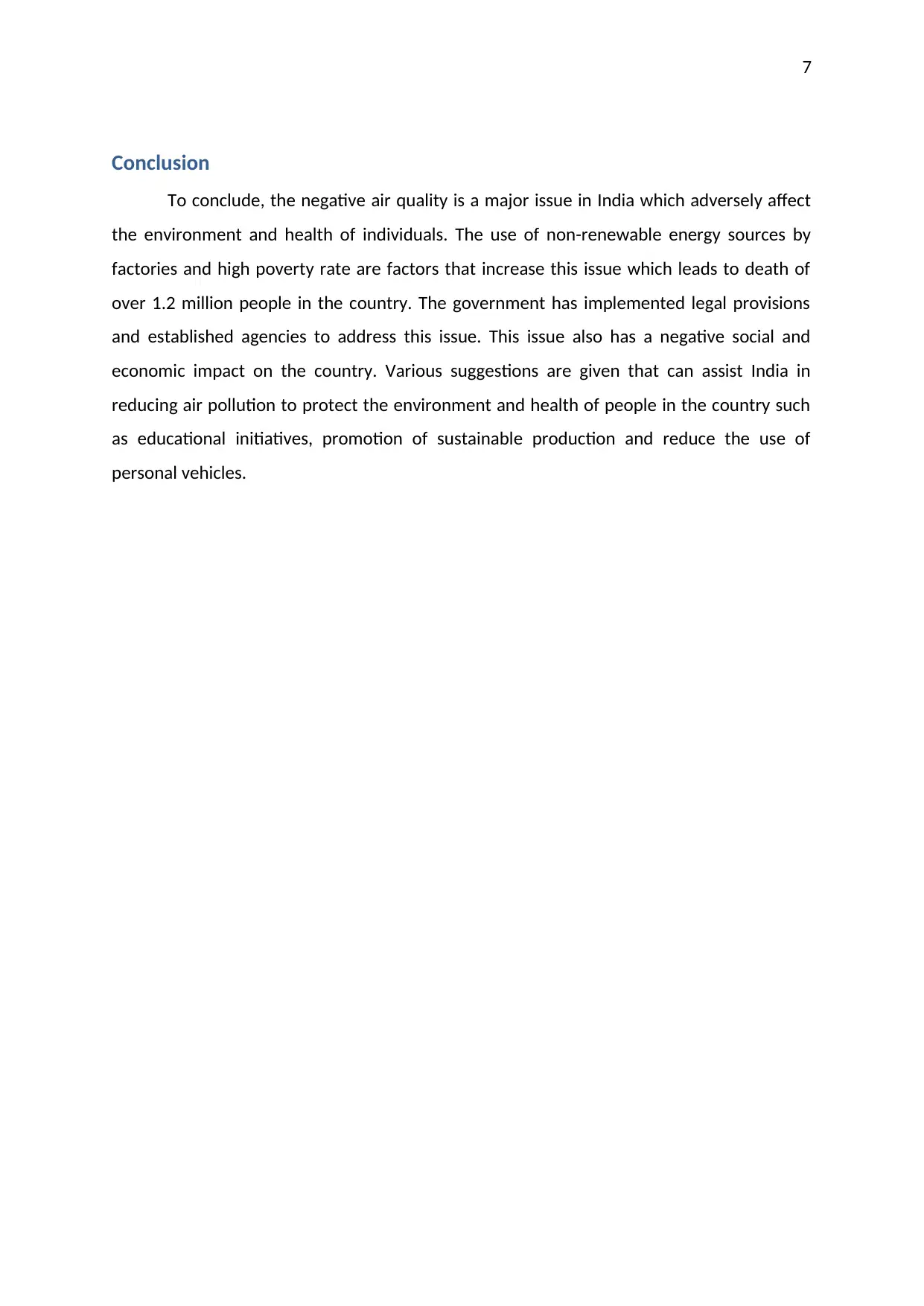
7
Conclusion
To conclude, the negative air quality is a major issue in India which adversely affect
the environment and health of individuals. The use of non-renewable energy sources by
factories and high poverty rate are factors that increase this issue which leads to death of
over 1.2 million people in the country. The government has implemented legal provisions
and established agencies to address this issue. This issue also has a negative social and
economic impact on the country. Various suggestions are given that can assist India in
reducing air pollution to protect the environment and health of people in the country such
as educational initiatives, promotion of sustainable production and reduce the use of
personal vehicles.
Conclusion
To conclude, the negative air quality is a major issue in India which adversely affect
the environment and health of individuals. The use of non-renewable energy sources by
factories and high poverty rate are factors that increase this issue which leads to death of
over 1.2 million people in the country. The government has implemented legal provisions
and established agencies to address this issue. This issue also has a negative social and
economic impact on the country. Various suggestions are given that can assist India in
reducing air pollution to protect the environment and health of people in the country such
as educational initiatives, promotion of sustainable production and reduce the use of
personal vehicles.
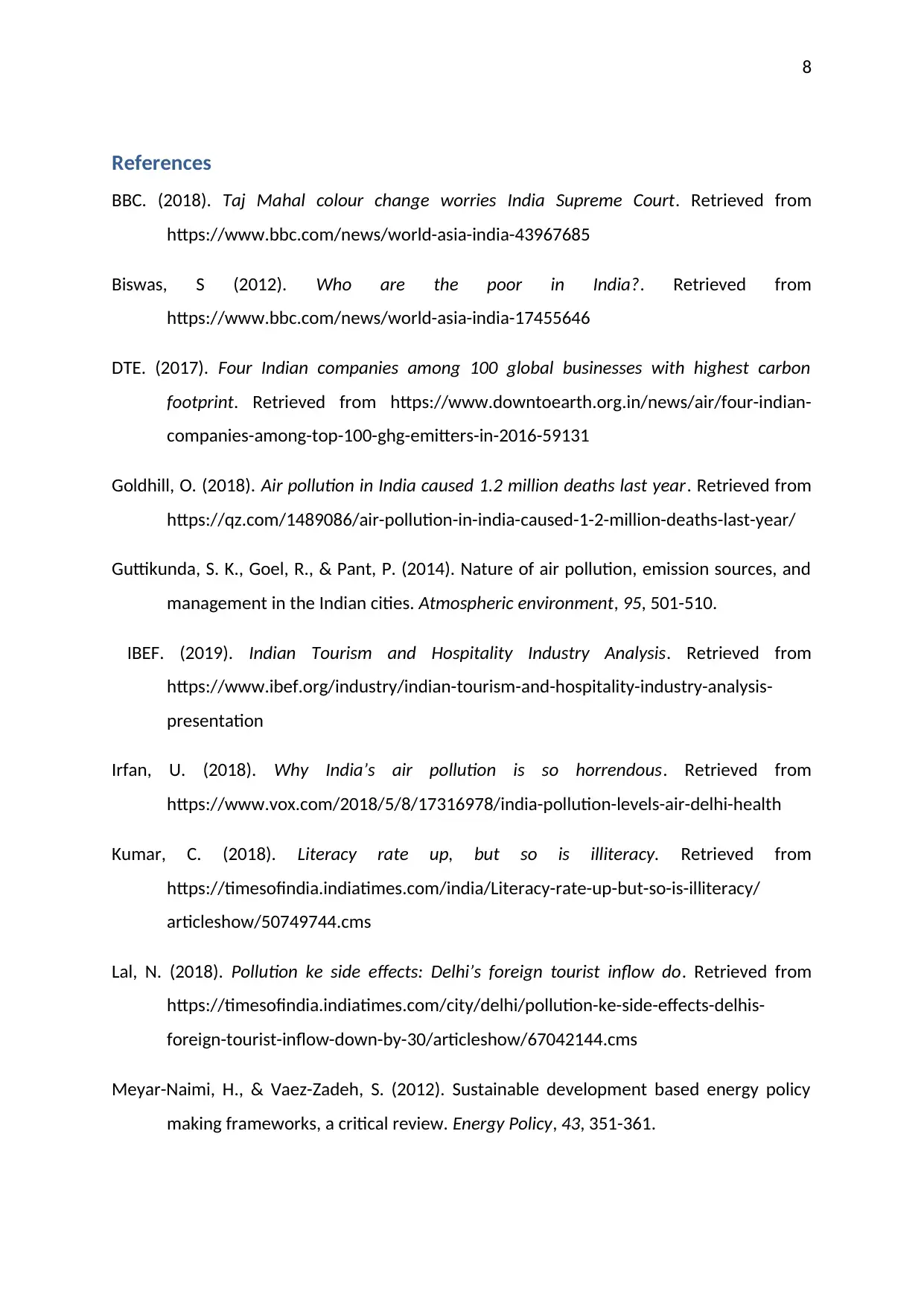
8
References
BBC. (2018). Taj Mahal colour change worries India Supreme Court. Retrieved from
https://www.bbc.com/news/world-asia-india-43967685
Biswas, S (2012). Who are the poor in India?. Retrieved from
https://www.bbc.com/news/world-asia-india-17455646
DTE. (2017). Four Indian companies among 100 global businesses with highest carbon
footprint. Retrieved from https://www.downtoearth.org.in/news/air/four-indian-
companies-among-top-100-ghg-emitters-in-2016-59131
Goldhill, O. (2018). Air pollution in India caused 1.2 million deaths last year. Retrieved from
https://qz.com/1489086/air-pollution-in-india-caused-1-2-million-deaths-last-year/
Guttikunda, S. K., Goel, R., & Pant, P. (2014). Nature of air pollution, emission sources, and
management in the Indian cities. Atmospheric environment, 95, 501-510.
IBEF. (2019). Indian Tourism and Hospitality Industry Analysis. Retrieved from
https://www.ibef.org/industry/indian-tourism-and-hospitality-industry-analysis-
presentation
Irfan, U. (2018). Why India’s air pollution is so horrendous. Retrieved from
https://www.vox.com/2018/5/8/17316978/india-pollution-levels-air-delhi-health
Kumar, C. (2018). Literacy rate up, but so is illiteracy. Retrieved from
https://timesofindia.indiatimes.com/india/Literacy-rate-up-but-so-is-illiteracy/
articleshow/50749744.cms
Lal, N. (2018). Pollution ke side effects: Delhi’s foreign tourist inflow do. Retrieved from
https://timesofindia.indiatimes.com/city/delhi/pollution-ke-side-effects-delhis-
foreign-tourist-inflow-down-by-30/articleshow/67042144.cms
Meyar-Naimi, H., & Vaez-Zadeh, S. (2012). Sustainable development based energy policy
making frameworks, a critical review. Energy Policy, 43, 351-361.
References
BBC. (2018). Taj Mahal colour change worries India Supreme Court. Retrieved from
https://www.bbc.com/news/world-asia-india-43967685
Biswas, S (2012). Who are the poor in India?. Retrieved from
https://www.bbc.com/news/world-asia-india-17455646
DTE. (2017). Four Indian companies among 100 global businesses with highest carbon
footprint. Retrieved from https://www.downtoearth.org.in/news/air/four-indian-
companies-among-top-100-ghg-emitters-in-2016-59131
Goldhill, O. (2018). Air pollution in India caused 1.2 million deaths last year. Retrieved from
https://qz.com/1489086/air-pollution-in-india-caused-1-2-million-deaths-last-year/
Guttikunda, S. K., Goel, R., & Pant, P. (2014). Nature of air pollution, emission sources, and
management in the Indian cities. Atmospheric environment, 95, 501-510.
IBEF. (2019). Indian Tourism and Hospitality Industry Analysis. Retrieved from
https://www.ibef.org/industry/indian-tourism-and-hospitality-industry-analysis-
presentation
Irfan, U. (2018). Why India’s air pollution is so horrendous. Retrieved from
https://www.vox.com/2018/5/8/17316978/india-pollution-levels-air-delhi-health
Kumar, C. (2018). Literacy rate up, but so is illiteracy. Retrieved from
https://timesofindia.indiatimes.com/india/Literacy-rate-up-but-so-is-illiteracy/
articleshow/50749744.cms
Lal, N. (2018). Pollution ke side effects: Delhi’s foreign tourist inflow do. Retrieved from
https://timesofindia.indiatimes.com/city/delhi/pollution-ke-side-effects-delhis-
foreign-tourist-inflow-down-by-30/articleshow/67042144.cms
Meyar-Naimi, H., & Vaez-Zadeh, S. (2012). Sustainable development based energy policy
making frameworks, a critical review. Energy Policy, 43, 351-361.
⊘ This is a preview!⊘
Do you want full access?
Subscribe today to unlock all pages.

Trusted by 1+ million students worldwide
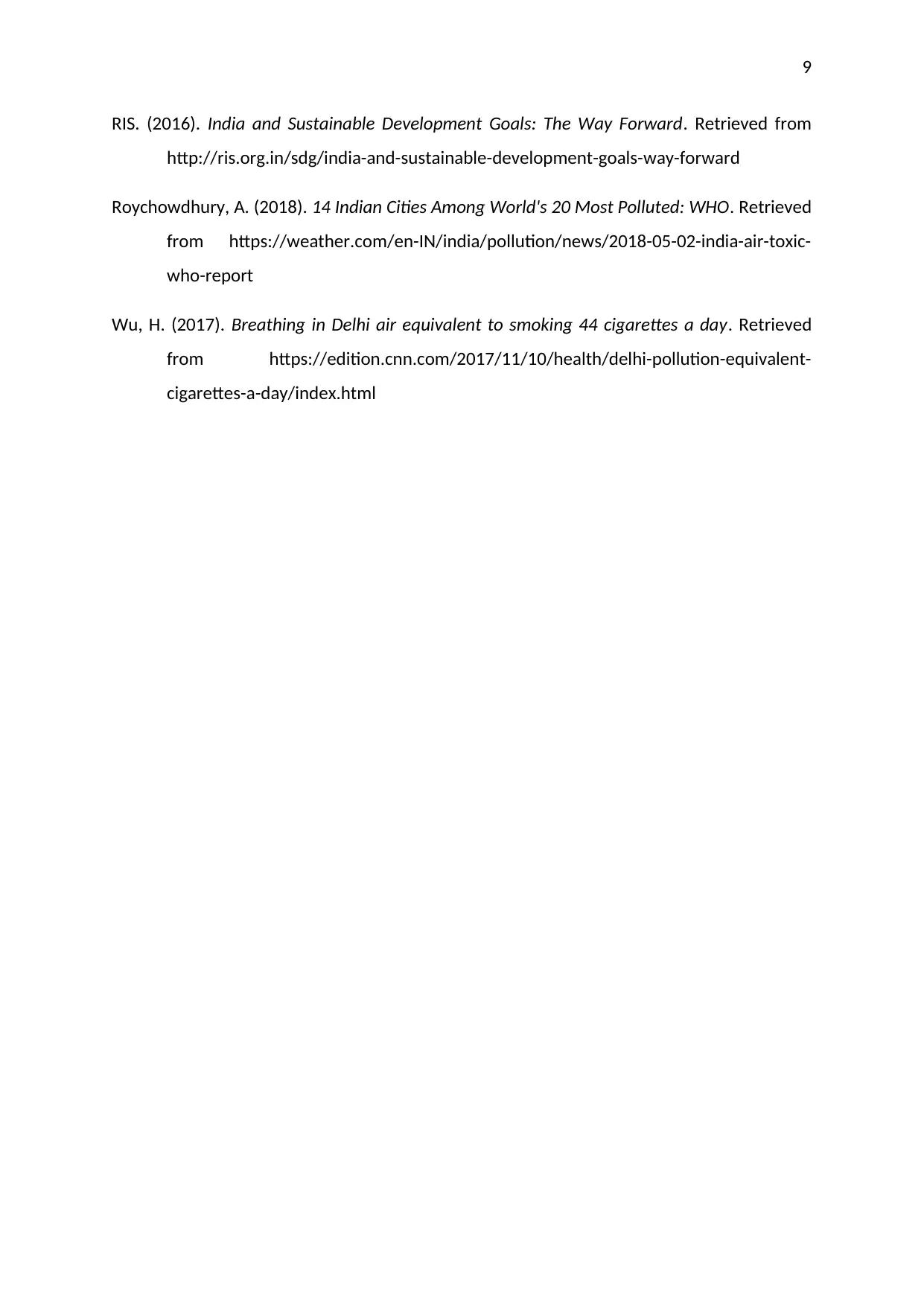
9
RIS. (2016). India and Sustainable Development Goals: The Way Forward. Retrieved from
http://ris.org.in/sdg/india-and-sustainable-development-goals-way-forward
Roychowdhury, A. (2018). 14 Indian Cities Among World's 20 Most Polluted: WHO. Retrieved
from https://weather.com/en-IN/india/pollution/news/2018-05-02-india-air-toxic-
who-report
Wu, H. (2017). Breathing in Delhi air equivalent to smoking 44 cigarettes a day. Retrieved
from https://edition.cnn.com/2017/11/10/health/delhi-pollution-equivalent-
cigarettes-a-day/index.html
RIS. (2016). India and Sustainable Development Goals: The Way Forward. Retrieved from
http://ris.org.in/sdg/india-and-sustainable-development-goals-way-forward
Roychowdhury, A. (2018). 14 Indian Cities Among World's 20 Most Polluted: WHO. Retrieved
from https://weather.com/en-IN/india/pollution/news/2018-05-02-india-air-toxic-
who-report
Wu, H. (2017). Breathing in Delhi air equivalent to smoking 44 cigarettes a day. Retrieved
from https://edition.cnn.com/2017/11/10/health/delhi-pollution-equivalent-
cigarettes-a-day/index.html
1 out of 10
Related Documents
Your All-in-One AI-Powered Toolkit for Academic Success.
+13062052269
info@desklib.com
Available 24*7 on WhatsApp / Email
![[object Object]](/_next/static/media/star-bottom.7253800d.svg)
Unlock your academic potential
Copyright © 2020–2025 A2Z Services. All Rights Reserved. Developed and managed by ZUCOL.





